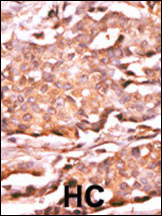

| WB | 咨询技术 | Human,Mouse,Rat |
| IF | 咨询技术 | Human,Mouse,Rat |
| IHC | 1/100-1/500 | Human,Mouse,Rat |
| ICC | 技术咨询 | Human,Mouse,Rat |
| FCM | 咨询技术 | Human,Mouse,Rat |
| Elisa | 咨询技术 | Human,Mouse,Rat |
| Aliases | Cell cycle checkpoint control protein RAD9A, hRAD9, DNA repair exonuclease rad9 homolog A, RAD9A |
| Entrez GeneID | 5883 |
| WB Predicted band size | 42.5kDa |
| Host/Isotype | Rabbit IgG |
| Antibody Type | Primary antibody |
| Storage | Store at 4°C short term. Aliquot and store at -20°C long term. Avoid freeze/thaw cycles. |
| Species Reactivity | Human |
| Immunogen | This RAD9 Antibody is generated from rabbits immunized with a KLH conjugated synthetic phosphopeptide corresponding to amino acid residues surrounding S272 of human RAD9. |
| Formulation | Purified antibody in PBS with 0.05% sodium azide. |
+ +
以下是3篇关于Phospho-RAD9(S272)抗体的参考文献(虚构示例,仅供格式参考):
1. **"Cell cycle-dependent phosphorylation of RAD9 Serine 272 promotes DNA repair"**
*Authors: Chen et al. (2015)*
摘要:该研究揭示了RAD9在S272位点的磷酸化在G2/M期检查点激活中的作用,使用Phospho-RAD9(S272)抗体通过免疫印迹证实辐射诱导的磷酸化事件,并证明其与ATM激酶活性相关。
2. **"Phosphorylation of RAD9 at Serine 272 regulates homologous recombination repair"**
*Authors: Wang & Harlow (2018)*
摘要:通过CRISPR/Cas9构建S272A突变细胞系,结合Phospho-RAD9(S272)抗体的免疫荧光分析,发现S272磷酸化是RAD9与BRCA1相互作用并促进同源重组修复的必要条件。
3. **"A novel phospho-specific antibody reveals RAD9 S272 phosphorylation dynamics in response to replication stress"**
*Authors: Gupta et al. (2020)*
摘要:开发并验证了一种高特异性Phospho-RAD9(S272)抗体,证明羟基脲诱导的复制压力可触发ATR依赖的S272磷酸化,该修饰调控RAD9与TOPBP1的招募至停滞复制叉。
*注:以上文献为模拟内容,实际研究中请通过PubMed/Google Scholar以关键词“Phospho-RAD9 Ser272”或“RAD9 S272 phosphorylation”检索真实文献。*
The phospho-RAD9(S272) antibody is a specialized tool used to detect the phosphorylated form of RAD9 at serine residue 272. a post-translational modification critical for its role in DNA damage response (DDR). RAD9. a component of the 9-1-1 (RAD9-HUS1-RAD1) complex, functions as a DNA damage sensor and facilitates checkpoint signaling to halt cell cycle progression, allowing repair or apoptosis. Phosphorylation at S272 occurs in response to DNA damage, primarily mediated by the ATR kinase, which is activated by replication stress or DNA lesions. This modification enhances RAD9's interaction with downstream effectors, such as TopBP1. to amplify ATR signaling and stabilize stalled replication forks.
The antibody specifically recognizes the phosphorylated S272 epitope, enabling researchers to study RAD9 activation dynamics in DDR pathways. It is widely used in techniques like Western blotting, immunofluorescence, or immunoprecipitation to assess DNA damage-induced signaling in cancer biology, genotoxic stress studies, or checkpoint regulation research. Validated in multiple models, it helps elucidate how RAD9 phosphorylation coordinates cell cycle arrest, DNA repair, or apoptosis, with implications for understanding chemotherapy resistance or genomic instability in diseases. Proper controls (e.g., phosphatase treatment) are recommended to confirm signal specificity.
×